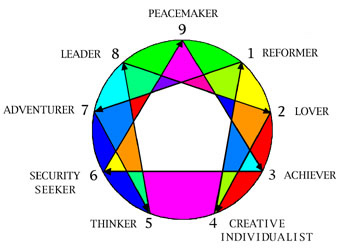The Enneagram of Personality Drives

Understanding People – The 9 Personality Drives
EMPOWERING WISDOM THROUGH THE ENNEAGRAM OF PERSONALITY
ENNEAGRAM CLASSES
INDIVIDUAL, COUPLE, and GROUP COUNSELING
Ken Jenkins: (510) 530-0484, kenjenkins@aol.com
I never cease to be amazed at the eloquence and clarity with which you explain the Enneagram. I always find your comments enlightening and I gain understanding about the workings of this simple yet complex system.
– Steve McKenzie
Ken’s Enneagram teachings are a treasure filled waterfall of pearls of wisdom and jewels of insight.
– Iasos
The Enneagram (the word means “a diagram with nine points”) is an ancient, yet state-of-the-art system of understanding our personality drives, often described as motivations. It reveals nine drives that are at first unconscious. Revealed, made conscious, those 9 drives illuminate an amazing amount of human behaviors.
The Enneagram is a kind of map, offering guidance on our path of growth and evolution. It can show us where we get stuck as well as the direction of our liberation.
We can use this wisdom to improve our relationships with our loved ones, our associates, and ourselves. Healing is a part of this increased understanding and compassion.
At its core, the Enneagram reveals nine motivating drives. These drives first emerge when we are very young, and evolve to become nine distinct survival strategies, nine ways of coping with the challenges of life.
Each of us has all nine drives, but not in equal proportion. For each of us, one is most important, most primal.
One of the two drives adjacent to the primary drive is a secondary part of our personal motivations, and is most often called the “wing”.
These drives are archetypal, powerful, primitive, and wonderful. They are a power, a force of energy that propels and compels us through life. From these drives, other personality characteristics arise.
By understanding these drives, we can better know why we have many of our various strengths and weaknesses. We can then use this knowledge to make more empowered choices.
Our personality drives reveal aspects of both our dark shadow and our bright potential, our lowest and highest sides. By learning about and harnessing these drives with their integrations and disintegrations (the arrows), we can create more success, happiness, and love in our lives and move forward more elegantly on our spiritual path home.
THE NINE DRIVES *
1 – To be right, reform, do it right, not make mistakes, follow rules, strive for ideals, change wrongs, make the world a better place.
2 – To love, be loved, care for, nurture, serve, give, be needed.
3 – To achieve, succeed, accomplish, perform, win praise for accomplishments, be appealing, please everyone.
4 – To be special, unique; to create (something special, unique, of oneself); to be noticed for special talents; to inspire. Longing – want to have but afraid to have.
5 – To think, to know (how it all works and why), to understand people and reality in order to gain a sense of safety, deal with fear through knowledge.
6 – To find safety and security by figuring out all the possible things that could go wrong or right, find haven, retreat, overcome fears, be safe through vigilance.
7 – To have fun, find awe, wonder; to dream, be happy, stay high; to avoid pain through many activities, projects, plans, ideas, friends.
8 – To be self reliant, lead, take charge by making own rules, decide the game, direct, call the shots; to avoid dependency and weakness by being self-reliant.
9 – To find and maintain peace, harmony, balance, quiet, gentleness; to avoid conflict by numbing own wants, desires, needs, and feelings.
* These drives and much of the other information here is based my understanding of the work of Lazaris, given at several 4-day Intensives on the Enneagram, starting in April of 1993. You can get information about the Lazaris material at http://www.lazaris.com.
A six audio CD set is available from one of those Enneagram Intensives. Also, there is a public library with an amazing amount of scintillating information on a wide variety of psychological, metaphysical, and spiritual topics.
One of the ways of learning the Enneagram is through exemplars – people who exemplify each of the nine types.
Different teachers of the Enneagram use somewhat different names for the types. As a guide through this maze, I have gathered all the names and phrases I could find into a kind of “Rosetta Stone” for Enneagram names. This “stone” also serves as a teaching tool.
The Enneagram is remarkably helpful for personal growth, relationships, and groups. It is used by therapists, counselors, management consultants, teachers, writers, and a rapidly increasing number of individuals who want to expand their self-awareness.
It gives a profound understanding of why people have different ways of seeing the world and handling life. It reveals deep motivations that lie hidden in the unconscious, and that lights a path to freedom, empowerment, and love.
Ken Jenkins teaches the Enneagram and uses it in counseling individuals, couples, and groups. His thorough knowledge of the Enneagram compliments a broad foundation of deep psychological understanding, gained from decades of study and personal growth work with Lazaris and many other teachers. Ken has studied with many of the major teachers of the Enneagram (including Don Richard Riso and Russ Hudson) and in the mid 1990’s, was a speaker at the two IEA (International Enneagram Association) conferences.
For more information about classes and counseling contact:
Ken Jenkins
kenjenkins@aol.com
(510) 530-0484


